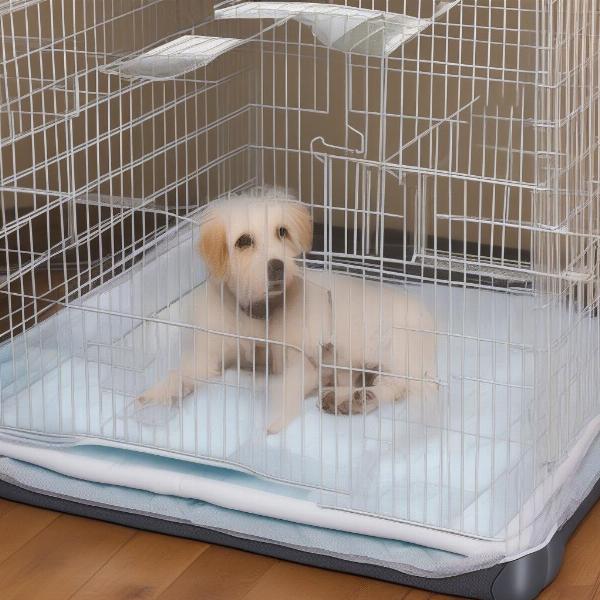Dog cage pads play a crucial role in a dog’s crate training journey and overall well-being. They provide comfort, help maintain hygiene, and even protect your dog’s joints. Whether you’re crate training a puppy, providing a safe space for an anxious dog, or simply creating a cozy den, the right dog cage pad is essential. This article will explore everything you need to know about choosing the perfect dog cage pads, from material and size to cleaning and maintenance.
Understanding the Importance of Dog Cage Pads
A crate should be a positive and comforting space for your dog, not a place of confinement. A comfortable dog cage pad helps create that positive association. It softens the hard crate floor, providing cushioning for joints and making the crate a more inviting place to rest. Furthermore, a good pad absorbs accidents, making clean-up easier and protecting your crate from damage.
Types of Dog Cage Pads
Several types of dog cage pads are available, each with its own pros and cons. Choosing the right one depends on your dog’s age, breed, and individual needs.
- Fleece Dog Cage Pads: Soft and warm, fleece pads are perfect for puppies and small dogs. They are washable and offer excellent comfort.
- Waterproof Dog Cage Pads: Ideal for puppies still being house-trained or dogs prone to accidents, waterproof pads prevent leaks and protect the crate floor.
- Orthopedic Dog Cage Pads: Designed for senior dogs or those with joint issues, these pads provide extra support and cushioning to alleviate pressure points.
- Cooling Dog Cage Pads: These pads contain gel or other cooling materials to help regulate your dog’s temperature during warmer months.
Choosing the Right Size and Fit
Choosing the correct size is crucial for comfort and safety. The pad should fit snugly within the crate, leaving enough space for your dog to move around comfortably. Measure your dog’s crate carefully before purchasing a pad. A pad that is too small will not provide adequate coverage, while a pad that is too large can bunch up and become a tripping hazard.
Material and Durability
Look for durable, high-quality materials that can withstand wear and tear. The material should be easy to clean and resistant to chewing or scratching. Consider your dog’s chewing habits when selecting a pad. Some pads are reinforced with chew-resistant materials for added durability.
Cleaning and Maintenance
Regular cleaning is essential for maintaining hygiene. Most dog cage pads are machine washable, which makes cleaning a breeze. Follow the manufacturer’s instructions for washing and drying to ensure the pad retains its shape and durability.
 Cleaning Dog Cage Pads
Cleaning Dog Cage Pads
Addressing Common Concerns: Chewing and Accidents
If your dog is a chewer, choose a durable, chew-resistant pad. For dogs prone to accidents, waterproof pads are a must. You can also consider using a crate liner dog for added protection. If your dog continues to chew or soil their pad, consult with a veterinarian or professional dog trainer to address any underlying behavioral issues.
Consider your dog’s sleeping style
Just like humans, dogs have preferred sleeping positions. Some like to curl up, while others stretch out. Consider your dog’s sleeping habits when choosing a pad. A thicker orthopedic pad might be better for a dog that likes to stretch out, while a thinner, more pliable pad might be suitable for a dog that likes to burrow. For dogs that like to move around in their crate, a 36in dog cage might be a more comfortable option.
Conclusion
Choosing the right dog cage pad is an important part of ensuring your dog’s comfort and well-being. By considering factors such as material, size, durability, and cleaning requirements, you can create a cozy and inviting den for your furry friend. A comfortable crate encourages relaxation and can make crate training a more positive experience. Remember, a happy dog is a well-rested dog!
FAQ
- How often should I wash my dog’s cage pad? It’s recommended to wash your dog’s cage pad at least once a week, or more frequently if needed.
- What material is best for a dog cage pad? The best material depends on your dog’s individual needs. Fleece is soft and comfortable, while waterproof materials are ideal for accidents. Orthopedic pads provide extra support for senior dogs.
- Can I use a human pillow in my dog’s crate? It’s generally not recommended to use human pillows in dog crates, as they can be a choking hazard.
- My dog keeps chewing his cage pad. What should I do? Consider a chew-resistant pad and consult with a veterinarian or trainer to address potential behavioral issues.
- How do I choose the right size dog cage pad? Measure your dog’s crate carefully to ensure a snug fit. The pad should be large enough to provide comfort but not so large that it bunches up.
- What if my dog has allergies? Look for hypoallergenic dog cage pads made with materials like bamboo or organic cotton.
- Are cooling dog cage pads safe? Yes, cooling pads are generally safe, but always supervise your dog and follow the manufacturer’s instructions.
Related Articles on ILM Dog
About ILM Dog
ILM Dog (ilmdog.com) is your trusted international resource for all things dog-related. We offer expert advice on dog breeds, health, training, nutrition, grooming, and much more, catering to both new and experienced dog owners worldwide. From selecting the right breed to understanding complex health issues, ILM Dog provides practical, reliable information. Our comprehensive guides on dog cage double options, setting up an electrical dog house, and selecting appropriate accessories ensure you have everything you need to care for your furry friend. Contact us for personalized advice: email [email protected] or phone +44 20-3965-8624.